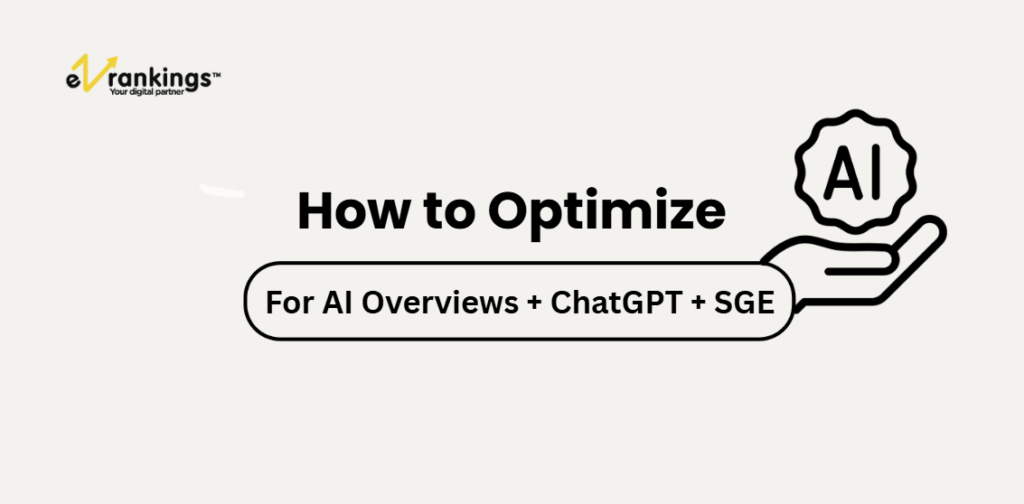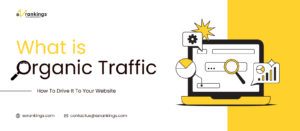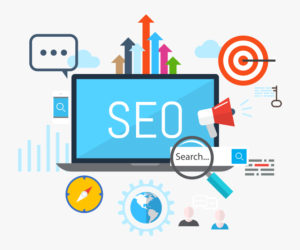How to Optimize for AI Overviews, ChatGPT, and Google’s Search Generative Experience (SGE)

The search environment is transforming at a fast pace and artificial intelligence is taking the lead. The internet is being changed into a discovery powered by AI that was previously a world of blue links and snippets. Search Generative Experience (SGE) and AI Overviews as well as ChatGPT, also known as conversational platforms are transforming the way people seek and engage with information.
To the marketers and SEO companies, this change is one thing, adjusting to a new form of visibility. Classical SEO is not about positions anymore, but about being familiar and mentioned in artificial intelligence tools that summarize and synthesize information. In order to remain competitive, you must have structured, authoritative and well understood content that can be comprehended by both machine and human.
Understanding AI Overviews, ChatGPT, and SGE
AI Overviews
AI Overviews are the AI-generated summaries by Google that are displayed at the top of the search results. These summaries are the collection of information about various reliable authorities to present users with faster, conversational responses. Contrary to the featured snippet which directs to a single page the AI Overviews uses a number of reliable sites to bring about accuracy and balance.
This is a significant development to the SEO specialists. Google is no longer rewarding high-ranking pages, it is rewarding understandable entities. Well-formatted clear content supported by authority now stands a better chance of being represented in these overviews.
Search Generative Experience (SGE)
SGE signifies the shift of Google towards conversational and interactive search. It enables the user to narrow down query, posing follow-up questions and explore subjects in a more interactive manner. This translates to more than simple optimization of key words to content creators. Your pages must expect the follow-up questions and give rational answers that expand on each other.
Semantic depth is the key to the optimization of SGE. The more connected ideas that have been discussed within the content, and the more contextually linked information that has been presented, the more likely it will be surfaced as a part of a generative conversation.
ChatGPT and AI Discovery Platforms
ChatGPT, Perplexity, Claude and others are now not just a chat tool anymore, they are becoming a new discovery engine. Individuals apply them to seek comparison, explanations and credible summaries. These systems draw data based on structured and valid as well as common sources.
Although you might not receive actual traffic information through these sites, the fact that they mention you or refer to it boosts brand acceptability. In the long run, such AI references help to create a sense of trust and promote users to your site or services indirectly.
Why Optimizing for AI Visibility Matters
The SEO model is not as a click-based one; it is progressing towards the visibility and authority based model. Although the AI-based search results may not necessarily result in direct clicks, still, the mentioning in AI-based search results can be evaluated as having some value. When your brand is used in AI-generated responses, it becomes recognized, trusted, and recollected more.
Initial research demonstrates that AIs are taking up an increasing portion of Google search results on the first page. Those companies that make their content AI-friendly will have a massive advantage in this new environment of hybrid search and synthesis.
Core Strategies to Optimize for AI Overviews and SGE
1. Strengthen Topical and Semantic Authority
Artificial intelligence applications such as Gemini and ChatGPT are contextual and relational more than keyword-based. Create topic clusters as opposed to wiring up dissimilar articles.
Begin with an overview pillar page that describes the primary topic, followed by secondary subpages that provide responses to intent-specific questions. Make them interdependent with descriptive anchor text to lay down a clear hierarchy. This not just enhances navigation to users but also aids AI in the way your content has been incorporated and boosts your inclusion in AI Overviews.
2. Use Structured Data and Schema Markup
AI visibility is based on structured data. Schema markup assists search engines and AI-based models to understand relationships, facts, and important attributes of your content.
Use schema types, FAQPage, HowTo, Review and Product. Make sure that the schema matches your visible content so as to ensure accuracy. Test all with Google Rich Results Test. Schema can be applied as AI language when properly used and can be used to make your pages speak to search engines.
3. Prioritize Factual, Authoritative, and E-E-A-T-Driven Content
Artificial intelligence focuses on the content that implies trust. To enhance your credibility, provide checked statistics, refer to trusted research, as well as emphasize professional views. Include author bios that show real life experience in their field and where possible, original case studies.
When you strengthen your Experience, Expertise, Authoritativeness and Trustworthiness (E-E-A-T), you have a higher likelihood of having AI tools choose your content as a credible source.
4. Optimize for Conversational and Intent-Based Queries
The AI systems not only consider the keywords but also their intent. Organize your content in such a manner that it resembles natural human speech. Use headings containing questions, and give brief answers right below the questions.
Adding questions and answers and focusing on long-tail queries, e.g. How can small businesses appear in AI Overviews, can make your content more closely resemble how people behave with applications like ChatGPT or Google SGE.
5. Make Content AI-Citable
To have your content be referred to by AI, it must be clear, extractable and be self-contained. Give definitions and brief explanations that are self-defining. Do not use filler or too creative words.
AI systems seek clarity and precision of facts. Consider your writing as a source of knowledge and not a sales pitch.
6. Enhance Page Experience and Accessibility
Although AI visibility is concerned with comprehension, the conventional SEO elements remain relevant. Quick loading, responsiveness on a mobile platform and consistent layouts are a necessity. An optimized user experience will keep your pages ranking along with adjusting to the AI-based search engines.
Optimizing for ChatGPT and AI Search Assistants
Get Indexed and Accessible
AI systems are dependent on the availability of quality and crawlable information. Ensure that your site is not blocking the indexing nor putting the valuable information behind the login walls. XML sitemaps, structured metadata, and appropriate robots.txt configuration can make your content more accessible and easier to read.
Create Response-Ready Content
ChatGPT prefers systematic and specific content. Issue how-to instructions, frequently asked questions, and listicles which summarize the important points. As soon as the information is organized and structured, AI tools can find it easier to extract and refer to it as a credible reference.
Build Mentions Across Trusted Sources
The AI discovery websites attach importance to the things that are found in more than one reliable location. Promote brand mentions using guest posts, interviews and collaborations. Get backlinks to the niche-related websites and remain active in the forum and the review platforms that are credible. All the mentioned brands enhance your authority signal that increases your presence in AI-generated summaries and responses.
Tracking AI Search Visibility
Determining how much AI-based search results recognize you is a new metric. The appearance of AI Overview or ChatGPT mentions could not be fully captured by the traditional rank-tracking tools, yet some of the platforms are working on capabilities to do so.
Such tools as BrightEdge Copilot and the AI Overview Tracker by Rank Ranger can also identify when your content is used in generative responses. Another tool that can be used to find conversational opportunities to target future content is the AlsoAsked and AnswerThePublic tool.
The Future of AI-Driven SEO
SEO is trending towards Answer Engine Optimization (AEO), where the win lies in being featured by AI instead of just being at the top of the position. The search experiences in the future will be a combination of text, images, and voice which will result in a more interactive atmosphere of discovery.
Marketers that want to remain competitive need to combine conventional SEO competencies with natural language processing, entity optimization, and structured data approaches. The early adapters are the ones who will spearhead the next generation of discovery based on AI.
Conclusion
Maximizing AI Overviews, ChatGPT, and SGE is no longer a choice, but the new visibility standard. With structured accuracy, topical authority, and the ability to have a conversation, your content will be able to remain topical in the era of AI-assisted search. At EZ Rankings, we specialize in AI-driven SEO services that help brands stay visible across traditional and generative platforms.






